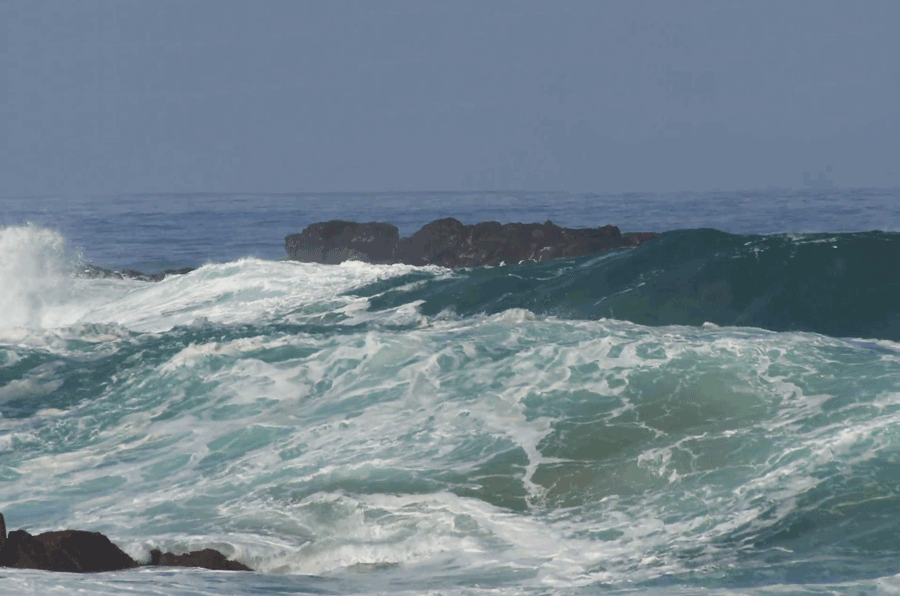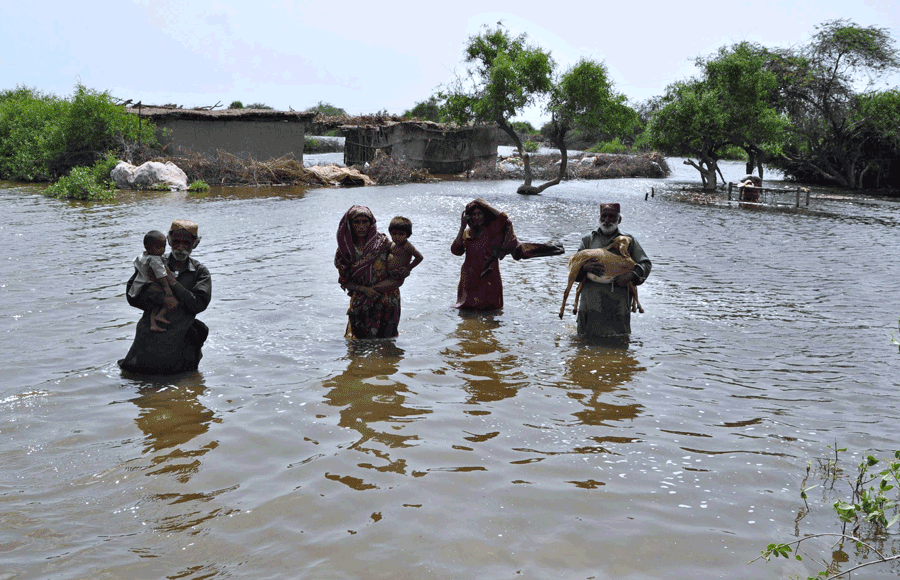Sea Change Ahead
By Muhammad Ismail Khan | Environment | Published 6 years ago
Whenever it doesn’t rain for long, or rains too much, words like “extreme weather” and “climate change” are bandied around. These terms, although not part of our day-to-day vocabulary, are used to contextualise any ‘abnormal’ climatic event.
So it was this Eid, in parts of Karachi, where movement was paralysed after a spell of heavy rain. But what happened in the city is just one example of how ill-prepared we are for such disasters. This August’s rains are a wake-up call to assess the vulnerability of our coastal towns to natural hazards.
Pakistan’s coastline has immense trading potential. It connects the Middle East with South Asia. Gwadar port, which is presently being developed, is projected to not only change the country’s destiny, but to alter global alignments. They say it will provide China a shorter route to the Middle East and beyond. Karachi is the country’s financial hub, precisely because of its port. The country’s major revenue comes from there.

The sea is thus an asset for Pakistan. Investing in coastal areas is in the interest not only of the coastal people, but the entire country. The question is, is our coastline vulnerable to climate change?
Anyone searching for “climate change” and “coastal cities” will come across the phenomenon of a rise in sea level. The warning is that the sea level is rising with each passing day, and if you want to stay safe, you had better stop that rise. As per existing knowledge, parts of Pakistan’s coastal belt, including parts of cities like Karachi, will be inundated with water at some point in the future.
Ibrahim Zia, research officer at the National Institute for Oceanology, said the exact estimate of how much the sea will rise along Pakistan’s coastal line is uncertain, but he adds, Pakistan’s “coastal cities are already in the vulnerable list of sea level rise.”
Sea intrusion is a separate phenomenon. Reportedly, thousands of acres in the coastal towns of Thatta and Badin are being encroached upon by the influx of sea water. The influx occurs when there is no fresh water coming from the other side to maintain equilibrium, or push back the sea water.
Strictly speaking, while a rise in sea level is linked to climate change, sea intrusion is the result of an absence of fresh water. In Pakistan’s case, sea intrusion is often attributed to the dams being built upstream. The more fresh water is stemmed or diverted upstream, the more water is blocked, and the less water is available for release. Downstream, where this water was supposed to fall into the sea, as there is less water, it is the sea that comes in, goes one argument. It means sea intrusion can be affected by climate change too: as water resources dry up, people are forced to build storages, which then affect the flow downstream.
Surely, both sea level rise and sea intrusion are deviations from the past, but they now occur so consistently that they are not that abnormal any more. They are debated and deliberated upon, at national and global levels. Many organisations working on environment issues have actually taken up this issue.
Worryingly, there are other seemingly inconsistent hazards, which are not only skipping policy makers’ attention but that of the community at large.
Jason Miklian, Senior Researcher, Peace Research Institute Oslo (PRIO), told Newsline that “One of the most challenging policy implications” of climate change in Pakistan will be that “its impact will be felt quite differently in different parts of the country. Coastal cities will also face unique challenges.”

District Badin was the worst hit in the unprecedented floods of 2010. Little has changed since.
Take tropical cyclones, the wind-like movement of water in the ocean. After travelling for miles, these cyclones hit nearby coastal areas, with damage and destruction measurable to their intensity. In Pakistan, whenever we talk about cyclones, one response is that of outright dismissal, considering them peculiar to the Pacific Ocean, hitting the Americas, or, at best, the Bay of Bengal. The Arabian Sea is presented as a calmer sea.
This memory is elusive. Climate change has made that very much a possibility. Although projections on when a cyclone may hit our coast may vary, the potential damage is great.
Adam Sobel, director of the Initiative on Extreme Weather and Climate, at Columbia University, USA, has written a book on how unprecedented yet catastrophic Hurricane Sandy was in the US in 2012, inflicting $70 billion in damage. In an email exchange with Newsline, he admits that “The Arabian Sea has fewer storms, and generally weaker ones, than the Bay of Bengal,” but adds “There are exceptions, and with warming, the models project more of those.” He believes that parts of Pakistan’s coastal line have rather more vulnerability to cyclones than Mumbai, which he has been studying. The frequency of such storms is increasing, so to say.
And that’s just one serious risk. There is a risk of tsunami, which is produced by an earthquake on the sea floor, causing waves to rise.
The coasts of Balochistan, as well as Karachi, are vulnerable to both earthquakes and tsunamis. According to Camila Penney, a geologist at the University of Cambridge, the tectonic plate that forms the floor of the Arabian sea is moving towards Pakistan, forming the Makran subduction zone, which can produce large earthquakes, and in turn tsunamis. “The floor of the Arabian sea is being pulled down beneath the southern coast of Pakistan, scraping up mud from the seafloor as it moves. This movement builds up stress, which is then released in earthquakes. And because this happens underwater, a big earthquake on the fault lines between the Arabian Sea floor and Pakistan could cause a tsunami.”
Scientists do not attribute this phenomenon to climate change, but the ensuing rise in sea level can aggravate the effects of a tsunami. As sea level rises, even a smaller tsunami can have devastating effects, they say. For those living on the coast, the changing weather portends severe effects. They might not be well-prepared to respond properly.
Almost anyone you reach out to regarding past trends refers to the November 1945 tsunami. Scientists found that earthquakes, too, occurred in the Makran subduction zone, which triggered a tsunami. Some estimates put the death toll at 4,000, in today’s Pakistan, Iran, Oman and India.
An earthquake similar to 1945 will bring more destruction, Dr. Penney warns. After all, population density has increased too. Novelist Amitav Ghosh, in The Great Derangement, notes how the rich living off the coastline, especially in towns built in colonial times, are vulnerable. As he reminds us, these cities have some of the most expensive lands facing the sea. In Pakistan too, the ‘best’ land is considered the one facing the coast. One hopes some preliminary feasibility studies are conducted before undertaking extensive construction in these areas.
The idea is not to alarm, but to ensure that we are all prepared for the future. If sea lanes can make a nation’s future, an understudied sea lane can break it. Even the most abnormal weather hits cannot be considered a deviation from the norm. Jason Miklian says that “the biggest problem” isn’t just that each cyclone becomes “a roll of the dice for large-scale disaster” only once. It is that “dice are being rolled more often, in more places, every year, including coastal Pakistan.”
Holistically speaking, the big policy challenge is how much should one spend, for how long, on which aspect of climate change. Government responses are often of immediate concern. “When thousands of farmers are seeing their crops turn to dust, and others are combating once-in-a-century flooding in other parts of the country,” says Jason Miklian, who has been studying the politics of climate change, “[for the government], it’s hard to justify spending precious resources instead on sophisticated sea barriers to deal with a future problem, in places like Gwadar.”
Already, when it comes to policy responses that take into account climate change, the concerns of upstream populations is given due consideration. Who can forget the euphoria surrounding dam construction! While the intent has been noble, one wonders if it was embraced by all, especially those downstream. Add to it the importance of coastal cities for the country’s economy. If climate change is a new source of conflict, one way new identities or interest groups can be formed will be upstream-downstream.
This is not to say the government has been merely a silent spectator on the coastlines. The provincial disaster management authorities have identified some risks too. In some cases, steps have already been taken. For instance, according to some reports, a tsunami warning system has been installed.
What is missing is a high level of awareness. Communities should stay alert. There is very little literature on the risks and preparedness of Pakistan’s coastal towns compared to, say, Shanghai, Hong Kong or Muscat. In a key informational work, the United Nations Educational, Scientific and Cultural Organisation (UNESCO) has published a special booklet on the 1945 Makran tsunami, documenting interviews with survivors of that tsunami. A special website with the booklet is now functional. Journalists and researchers can extract information from that and design campaigns.
Above all, Pakistan should facilitate climate researchers to study the potential changes. The starting point should be proper data. Ibrahim Zia said that while “some indicators [of climate change] are obvious now,” yet “many of the other effects require data collection.”
When it comes to climate change, stating fact as theory or otherwise has been a big issue for those working on climate change. Aisha Khan, who heads the Civil Society Coalition for Climate Change (CSCCC), reminds us that populists the world over are constructing facts or relying on emotions. Pakistan’s case in terms of questioning over data is unique: There is scant data on the one hand, and then, as Aisha Khan says, the “credibility” of data is at times questionable.
Columbia’s Adam Sobel says, “Pakistan would be well-advised to study the risk and have some level of preparation,” when it comes to tropical cyclones. Some researchers face difficulty, not necessarily because of the terrain but because of the security situation. That should change. The government should constitute a committee of experts to help study the belt, on which the entire country is literally dependent, in the present and in the future. Karachi and Gwadar deserve investment towards this end.
Jason Miklian warns that climate-induced disasters, if not handled properly, can lead to political instability. We saw this recently with the rains in Karachi: various departments in the city, which are in a multitude, started pointing fingers at each other. Human inaction was taken to task. But as Miklian himself adds, only an efficient response can earn trust. That should be the goal.


